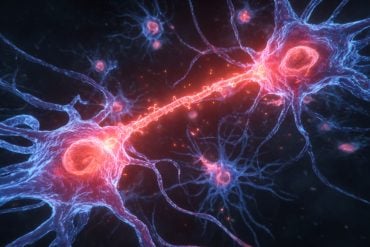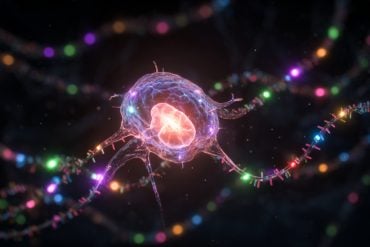Summary: New research reveals how dopamine helps the brain learn to avoid unpleasant outcomes by responding differently in distinct brain regions during negative experiences. In a study with mice, scientists tracked dopamine activity over time as animals learned to escape an adverse event, showing that one brain area adapted early in learning while another supported long-term avoidance behavior.
These findings challenge simplistic views of dopamine as purely “rewarding” and suggest it plays a critical role in adaptive — and maladaptive — learning from threats. The study may offer insights into psychiatric conditions marked by excessive avoidance, like anxiety and OCD, and underscores why the trendy idea of a “dopamine detox” misses the complexity of this vital brain chemical.
Key Facts:
- Dopamine Evolves With Learning: Dopamine activity changes over time depending on how well an animal learns to avoid danger.
- Different Brain Areas, Different Roles: The ventromedial shell responds early in avoidance learning; the core supports long-term threat prediction.
- Oversimplified Detox Trend: The popular “dopamine detox” wellness trend ignores dopamine’s crucial role in adaptive behavior and learning.
Source: Northwestern University
Dopamine is the brain’s motivational spark, driving us to chase what feels good, say scrolling another reel on social media, and steer clear of what doesn’t, like touching a hot stove.
But scientists haven’t fully understood how dopamine helps us learn to avoid bad outcomes — until now.

A new study from Northwestern University shows that dopamine signals in two key brain areas involved in motivation and learning respond differently to negative experiences, helping the brain adapt based on whether a situation is predictable or controllable.
While previous research has shown that dopamine can respond to negative experiences, this is the first study to track how those signals evolve over time as animals move from novices to experts in avoiding them.
The study will be published April 22 in the journal Current Biology.
The study authors said the findings help explain how we learn from bad experiences, and why some people learn to avoid danger better than others.
They also shed light on how excessive avoidance — a hallmark symptom of multiple psychiatric conditions such as anxiety, obsessive-compulsive disorder and depression — may come to be via alterations in dopamine function.
This can lead to an overestimation of danger in the environment and a decreased quality of life as the brain prioritizes avoiding certain experiences.
Finally, the study helps explain why the concept behind the recent “dopamine-detox” wellness trend is too simplistic.
“Dopamine is not all good or all bad,” said first author Gabriela Lopez, a doctoral candidate in the Interdepartmental Neuroscience Program at Northwestern University Feinberg School of Medicine.
“It rewards us for good things but also helps us tune into cues that signal trouble, learn from consequences and continuously adapt our learning strategies in unstable environments.”
How the study worked
In the study, scientists trained mice to respond to a five-second warning cue that predicted an unpleasant outcome. If the mice moved to the other side of a two-chamber box during the warning cue, they could avoid the outcome entirely.
As the mice learned the task, researchers recorded dopamine activity in two areas of the nucleus accumbens, a brain region involved in motivation and learning.
Previous research had suggested that dopamine in the ventromedial shell of the nucleus accumbens increases during bad experiences, while dopamine in the core of the nucleus accumbens decreases.
Therefore, the scientists wanted to understand how these different dopamine responses work together when the mice learn to avoid bad experiences.
They found that the two areas of the nucleus accumbens responded differently:
- In the ventromedial shell, dopamine levels initially surged in response to the unpleasant event itself. As the mice actively learned about the meaning of the warning cue, the dopamine response shifted to the cue itself. Eventually, though, the dopamine response faded away as the mice became skilled at avoiding the outcome.
- In the core, dopamine decreased for both the unpleasant event and the warning cue. The reduction in dopamine in response to the warning cue steadily increased throughout training, especially as the mice became more successful at avoiding the event.
“These responses are not only different in their sign — where in one area, dopamine goes up for something bad and, in the other area, it goes down for something bad — but we also saw that one is important for early learning while the other one is important for later-stage learning,” said corresponding author Talia Lerner, associate professor of neuroscience and psychiatry and behavioral sciences at Feinberg.
Later, the researchers tested what would happen when the outcome couldn’t be avoided, regardless of the mice’s actions.
Under those conditions, dopamine patterns returned to what they looked like earlier in training — suggesting that these brain signals are sensitive to context and may help animals adapt their behavior when the environment changes.
“This shows that the dopamine signals are flexible, sensitive to task rules, and may help us adapt to changes in the environment,” Lopez said.
Why a ‘dopamine detox’ is too simplistic
People have been singing the praises of the “dopamine detox” wellness trend — cutting out things that trigger a dopamine rush, like eating junk food or scrolling social media, to regain control over these behaviors.
But this study helps explain why the concept of a “dopamine detox” is too simplistic.
“We think of dopamine as a learning molecule that is important for normal behavior in everyday life,” Lopez said. “So, cutting it out completely can do more harm than good.”
Next steps
“The dopamine signals we are studying are important for representing aversive signals that are involved in problems like chronic pain, depression and withdrawal from addictive substances,” Lopez said.
“Overactive avoidance learning may also be a pathway that contributes to obsessive-compulsive disorder and other clinical anxiety disorders. We hope to follow up on these basic research findings to address clinical problems affecting patients.”
About this dopamine and learning research news
Author: Kristin Samuelson
Source: Northwestern University
Contact: Kristin Samuelson – Northwestern University
Image: The image is credited to Neuroscience News
Original Research: Open access.
“Region-specific nucleus accumbens dopamine signals encode distinct aspects of avoidance learning” by Gabriela Lopez et al. Current Biology
Abstract
Region-specific nucleus accumbens dopamine signals encode distinct aspects of avoidance learning
Avoidance learning—learning to avoid bad outcomes—is an essential survival behavior. Dopamine signals are widely observed in response to aversive stimuli, indicating they could play a role in learning about how to avoid these stimuli.
However, it is unclear what computations dopamine signals perform to support avoidance learning. Furthermore, substantial heterogeneity in dopamine responses to aversive stimuli has been observed across nucleus accumbens (NAc) subregions.
To understand how heterogeneous dopamine responses to aversive stimuli contribute to avoidance learning, we recorded NAc core (Core) and NAc ventromedial shell (vmShell) dopamine during a task in which mice could avoid a footshock punishment by moving to the opposite side of a 2-chamber apparatus during a 5-s warning cue. Both signals evolved substantially—but differently—with learning.
We found that Core and vmShell dopamine signals responded oppositely to shocks at the beginning of training and oppositely to warning cues as cue-shock associations developed in mid-training.
Core dopamine responses strengthen with learning and are especially evident during expert performance. vmShell dopamine responses to cues and shocks were present during early learning but were not sustained during expert performance.
Our data support a model in which Core dopamine encodes prediction errors that guide the consolidation of avoidance learning, while vmShell dopamine guides initial cue-shock associations by signaling aversive salience.






